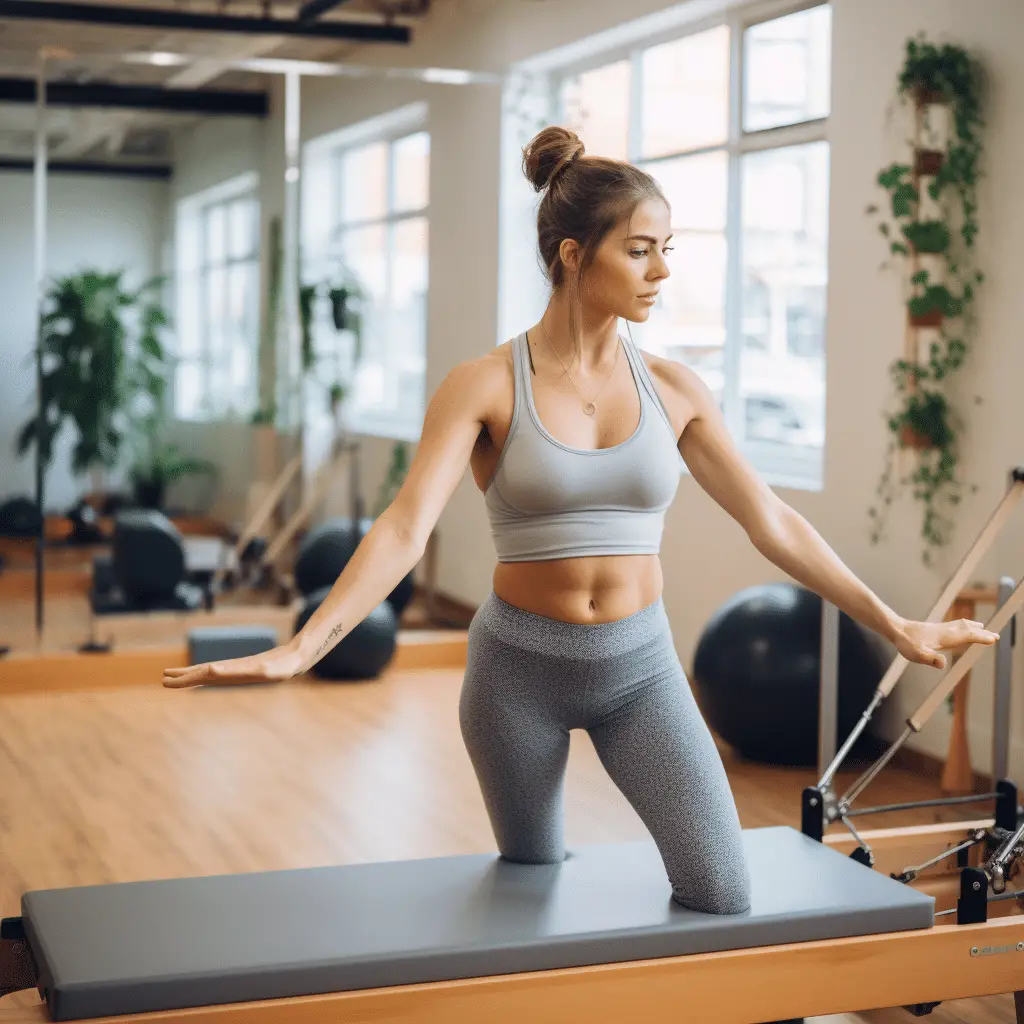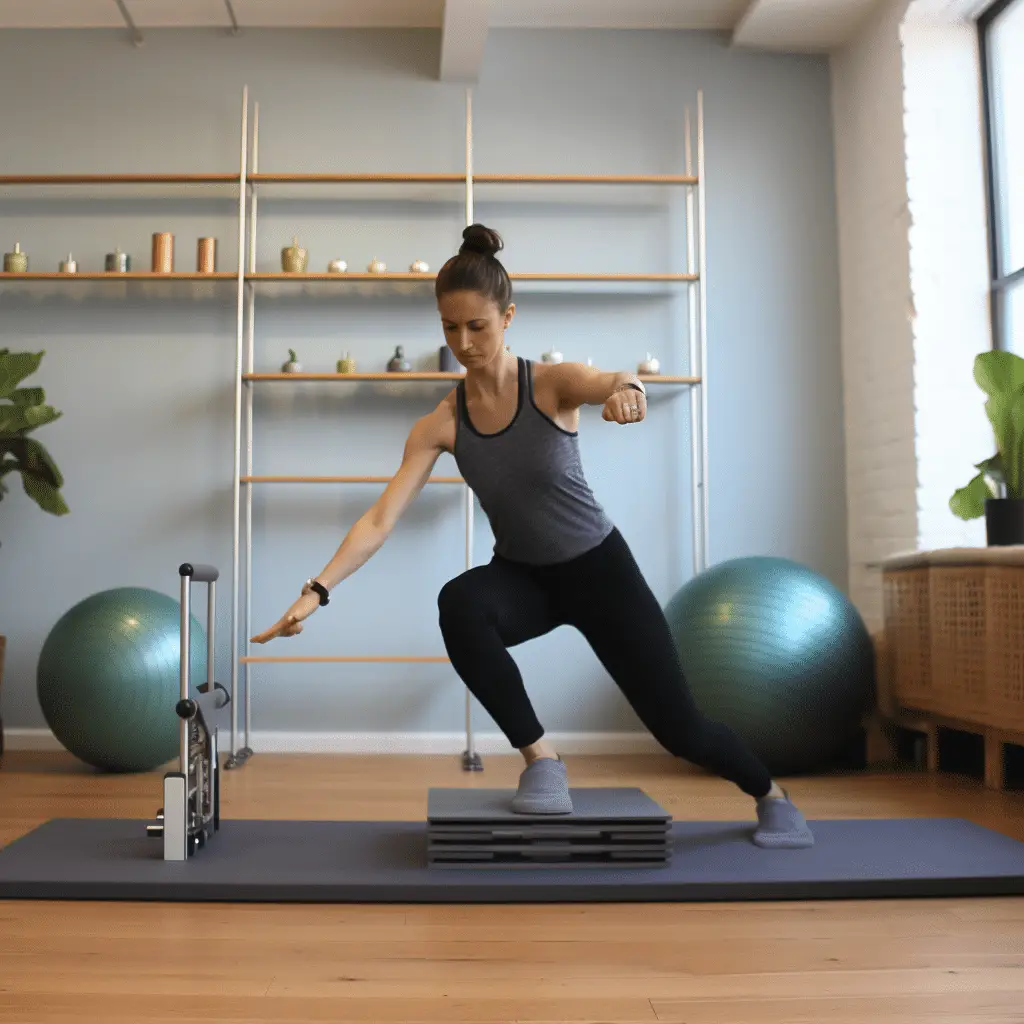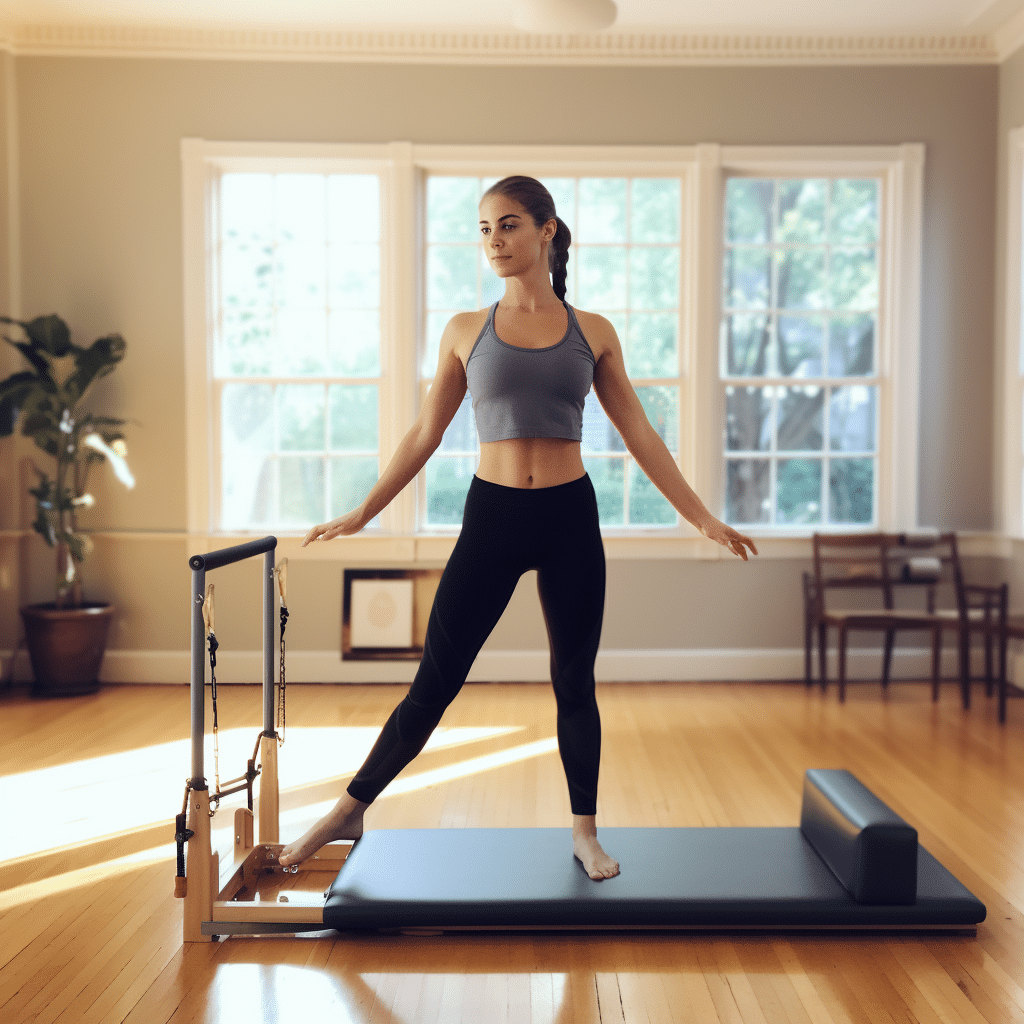Introduction
How Long Should A Pilates Workout Be: The duration of a Pilates workout is a question that frequently arises among fitness enthusiasts, both beginners and experienced practitioners alike. Pilates, a mind-body exercise system developed by Joseph Pilates in the early 20th century, is renowned for its ability to enhance core strength, flexibility, balance, and overall well-being. While the effectiveness of Pilates is well-established, the ideal length of a Pilates session can vary depending on individual goals, fitness levels, and schedules. In this exploration, we will delve into the factors that influence the duration of a Pilates workout, providing insights to help you tailor your practice to suit your specific needs and aspirations. Whether you’re aiming for a quick and efficient routine or a more comprehensive session, understanding the variables at play will empower you to make the most of your Pilates practice.
Your current fitness level plays a significant role in determining the length of your Pilates session. Beginners may find it beneficial to start with shorter workouts, typically ranging from 15 to 30 minutes. As your strength and endurance improve, you can gradually extend your sessions. The specific goals you have in mind for your Pilates practice will also impact the duration.
If you’re looking for a quick, daily routine to improve posture and flexibility, a shorter session can suffice. In contrast, if you aim to build significant core strength, improve muscle tone, or rehabilitate an injury, longer, more intensive workouts may be necessary. One of the practical considerations when deciding on the duration of your Pilates workout is your schedule. If you have limited time, shorter sessions may be more feasible and can still provide benefits. Alternatively, if you can allocate more time, you can engage in a more comprehensive practice.

How long is a normal Pilates session?
Pilates classes typically take 45 minutes to an hour, but you can do fewer moves in less time. You’ll get stronger, more sculpted muscles and gain flexibility.
Efficiency and Focus: Pilates is known for its precision and attention to detail. In a 45-minute to 1-hour session, participants can fully engage with the exercises and movements without feeling rushed. This duration allows for a thorough warm-up, the execution of various exercises, and a proper cool-down.
Physical Endurance: Pilates exercises often engage the core muscles and promote overall body strength, flexibility, and endurance. An hour-long session allows individuals to gradually build their stamina and challenge their bodies in a controlled and sustainable manner.
Variety and Progression: Instructors can incorporate a variety of exercises, equipment (such as reformers and resistance bands), and modifications within an hour-long class. This variety helps keep participants engaged and allows for progression as they become more skilled and experienced.
Mind-Body Connection: Pilates emphasizes the mind-body connection, encouraging participants to focus on their breath, alignment, and movement precision. A longer session duration permits individuals to develop and deepen this connection over time.
Individual Goals: While 45 minutes to 1 hour is considered standard, session lengths can be adjusted to align with individual goals. Some may opt for shorter sessions for a quick workout, while others may extend their practice to 75 or 90 minutes for a more comprehensive workout experience.
How long should I do Pilates for results?
While individual results may vary, most people can see noticeable body changes within just three weeks. However, those who do Pilates less often may take up to eight weeks to see noticeable results in their bodies.
Fitness Level: Your current fitness level plays a significant role in how long it will take to see results. If you are relatively new to exercise, you may notice improvements more quickly compared to someone who is already highly trained.
Consistency: Consistency is key in any fitness routine. To see consistent progress, it is generally recommended to practice Pilates at least 2-3 times per week. This regularity allows your body to adapt and improve over time.
Intensity: The intensity of your Pilates workouts can impact the speed of your results. A higher-intensity session, such as advanced Pilates or incorporating resistance equipment like reformers, may yield faster results compared to gentler, mat-based workouts.
Specific Goals: Your specific fitness goals will also determine how long it takes to see results. For instance, if you’re looking to improve flexibility and posture, you may notice positive changes sooner than someone aiming to build significant muscle mass.
Diet and Lifestyle: Your overall lifestyle, including diet and other activities, can influence the rate of your progress. A balanced diet that supports your fitness goals and adequate rest are important factors in achieving results.
Is 20 minutes of Pilates a day enough to Lose Weight?
Is 20 minutes of Pilates a day enough to get results? The short answer is… absolutely! Keep reading to learn how to incorporate 20-minute Pilates challenges into your routine for a consistent and beneficial Pilates practice.
Calorie Burn: Pilates is not a high-impact, calorie-burning exercise like running or HIIT (High-Intensity Interval Training). A 20-minute Pilates session can burn calories, but it typically burns fewer calories compared to more vigorous forms of exercise. The exact number of calories burned depends on factors like your weight, intensity, and the specific Pilates exercises you’re doing.
Weight Loss Equation: Weight loss is fundamentally about creating a calorie deficit, where you burn more calories than you consume. A 20-minute Pilates session can help you burn some calories, but it may not create a substantial calorie deficit on its own. Therefore, weight loss through Pilates alone might be slow and limited.
Consistency: Consistency is vital when using Pilates as a tool for weight management. Doing 20 minutes of Pilates daily can contribute to overall physical fitness and may help with weight maintenance. However, for more significant weight loss, you may need to supplement your Pilates routine with other forms of exercise and dietary adjustments.
Strength and Muscle Tone: Pilates can help build lean muscle mass, which can indirectly aid in weight management. Muscle burns more calories at rest than fat, so as you build muscle through Pilates, your metabolism may increase, making it easier to maintain a healthy weight.
Is 30 minutes of Pilates a day enough exercise?
30 minutes of Pilates a day is more than sufficient. While Pilates was designed to be safe for daily exercise, for beginners two to three sessions a week in 30-minute intervals is a high enough frequency and duration to produce desired fitness results.
Core Strength and Stability: Pilates is renowned for its focus on core strength, and 30 minutes a day can significantly contribute to improving your core muscles. This can help with better posture, reduced risk of back pain, and enhanced stability in daily activities.
Flexibility and Mobility: Pilates incorporates stretches and movements that can enhance flexibility and joint mobility. Regular practice can lead to increased range of motion in various joints.
Improved Muscle Tone: Pilates engages various muscle groups, promoting lean muscle development. Over time, this can lead to improved muscle tone and a more sculpted appearance.
Stress Reduction: The mindful and controlled movements in Pilates can provide stress relief and relaxation. It’s an excellent way to de-stress after a long day.
Better Body Awareness: Pilates emphasizes body awareness, helping you become more in tune with how your body moves and feels. This can lead to improved posture, balance, and coordination.
Which is harder yoga or Pilates?
Pilates is certainly a more intense workout that burns calories faster and produces physical results quicker, so you could make the argument that Pilates is the harder of the two. But again, everything comes down to what you wish to get out of the class and the methods your instructor takes to get you there.
Yoga
Variety of Styles: There are various styles of yoga, ranging from gentle and restorative (e.g., Hatha or Yin) to highly dynamic and physically demanding (e.g., Vinyasa or Power Yoga). The difficulty level can vary greatly depending on the chosen style.
Balance and Stability: Many yoga poses require balance and stability. Balancing on one leg or holding a pose for an extended period can challenge your strength and coordination.
Strength and Endurance: While yoga primarily focuses on flexibility and balance, it can also build strength, especially in the core and upper body, through poses like Plank and Chaturanga.
Pilates
Core Strength: Pilates is known for its emphasis on core strength and stability. The exercises often target the abdominal muscles, which can be particularly challenging.
Controlled Movements: Pilates requires precise, controlled movements, which can be mentally and physically demanding. Maintaining proper form and alignment is crucial.
Equipment and Resistance: Some Pilates workouts involve specialized equipment like reformers, which add resistance to exercises, increasing the intensity. This can make Pilates more challenging for some individuals.
Is 1 hour Pilates a day enough?
For most individuals, sticking to 20 minutes for a Pilates session is enough. So, 20 minutes / 3 times a week is a good schedule to begin with. You may find that as you get more comfortable with the routines and you begin to get stronger and more flexibile that you will want to increase this to 30 minutes or more.
Comprehensive Workout: An hour of Pilates provides ample time to engage in a comprehensive workout that covers various aspects of fitness, including core strength, flexibility, balance, posture, and overall body awareness.
Core Strength: Pilates is renowned for its focus on developing core strength, which can help improve stability and reduce the risk of back pain and injuries.
Flexibility and Mobility: Extended Pilates sessions allow for deeper stretching and enhanced joint mobility, which can improve overall flexibility and range of motion.
Improved Muscle Tone: Regular one-hour Pilates sessions can lead to improved muscle tone throughout the body, promoting a lean and sculpted appearance.
Mind-Body Connection: Pilates emphasizes mindfulness and concentration on precise movements, enhancing the mind-body connection and reducing stress.
Is Pilates alone enough exercise?
Is Pilates Enough of a Workout? Pilates is enough of a workout for one session; however, it’s important to vary your workouts based on your goals throughout your fitness journey. This means performing different styles of workouts that compliment your fitness goals.
Fitness Goals: The appropriateness of Pilates as your sole exercise depends on your specific goals. If your primary objectives are to improve core strength, flexibility, posture, and overall body awareness, Pilates can be highly effective. However, if you have other fitness goals, such as cardiovascular fitness, muscle hypertrophy (building larger muscles), or specific sports performance improvements, you may need to supplement Pilates with other forms of exercise.
Cardiovascular Fitness: Pilates is not primarily a cardiovascular exercise. If you aim to enhance your cardiovascular fitness or burn a significant number of calories, you may need to incorporate aerobic activities like running, cycling, or swimming into your routine.
Variety: While Pilates offers many exercise variations, it may not provide the same variety and diversity of movements as a well-rounded fitness program. A mix of different exercises can help prevent boredom and plateaus in your fitness journey.
Strength Training: Pilates can improve muscular endurance and functional strength, but if you’re looking to build significant muscle mass, a dedicated strength training program may be necessary.
What happens to body after Pilates?
‘Pilates focusses on lengthening and expanding the muscles, instead of bunching them up. This therefore allows them to become longer and leaner,’ says Mahal. ‘You will feel taller and will become longer and leaner. The exercises within Pilates are dynamic stretches, which mean they are active movements.
Improved Core Strength: One of the primary benefits of Pilates is enhanced core strength. Regular Pilates practice targets the muscles of the abdomen, lower back, and pelvis. This can lead to a stronger and more stable core, helping to improve posture and reduce the risk of back pain.
Better Posture: Pilates emphasizes alignment and body awareness. As you develop core strength and become more conscious of your body’s positioning, you’ll likely notice an improvement in your posture. This can contribute to a more upright and confident appearance.
Increased Flexibility: Pilates incorporates stretching exercises that promote flexibility and joint mobility. Over time, you may find that you can move more freely and comfortably in your daily life.
Enhanced Muscle Tone: Pilates can help tone and sculpt muscles throughout the body, giving you a lean and well-defined appearance. While it may not lead to significant muscle hypertrophy (muscle growth), it can improve muscle definition.
Improved Balance and Coordination: Many Pilates exercises require balance and coordination. Regular practice can enhance your proprioception (awareness of your body’s position in space) and stability.

Conclusion
The length of a Pilates workout depends on your fitness level, goals, schedule, and preferences. Consistency and listening to your body are important. Pilates builds strength, flexibility, and well-being over time. Find a duration that works for you with the help of a certified instructor. Your ideal Pilates workout duration may change as you progress. Keep track of your progress and adjust your routine if needed.
To choose the appropriate workout, you must consider how long you exercise and how hard you push yourself. If you’re unsure or have health concerns, it’s best to talk with a certified Pilates instructor or fitness expert.
They can assess your individual needs and create a tailored workout plan to help you achieve your goals safely and efficiently. In summary, the duration of your Pilates workout should be a well-considered aspect of your fitness routine. It should align with your objectives, skill level, and schedule while accommodating warm-up and cool-down periods. Flexibility is key, allowing you to adapt your routine as you progress and ensuring that your Pilates practice remains enjoyable and beneficial for your overall well-being.

